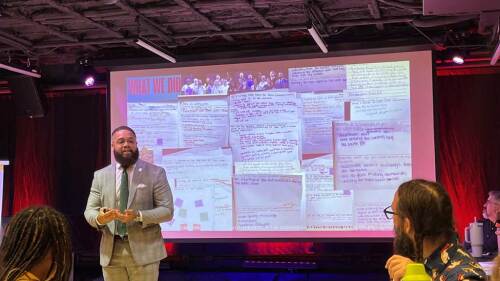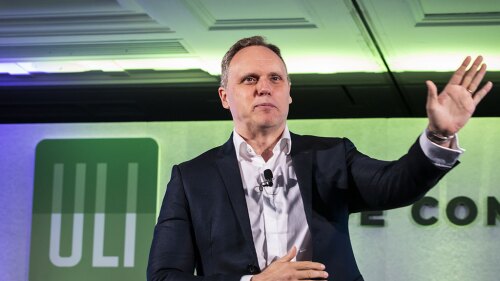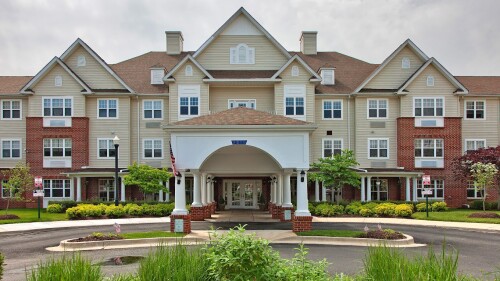
Zena Diggs, senior vice president Bank of America; Jill Castilla, president & CEO, Citizens Bank of Edmond; Brian Waldman, chief investment officer, Peachtree Group; Gary Dinka, managing director, MetLife Real Estate & Agricultural Investments: and Adam Ducker, CEO, RCLCO, speaking at a panel on debt at the 2025 ULI Spring Meeting.
ULI/Anita Kramer
For the right deal, there is available debt. Bigger questions loom for borrowers these days, though. What does the “right” deal look like? How can a borrower best position their deal to be the right one?
Capital is widely available for real estate borrowers, and lenders are eager to do business. This takeaway was a key theme from the “Capital Markets: Securing Debt Today” session held Monday at the 2025 ULI Spring Meeting in Denver, Colorado. Capital markets haven’t been immune to the volatility and uncertainty created by the global trade war, however. The availability of capital also depends on who is asking, with a clear bifurcation between high-quality deals and sponsors—and everyone else.
“We’ve seen a lot of change happening here, at the first of the year, that’s just causing a little bit of a bumpy ride, but I think the rest of 2025 is really going to start settling,” says Jill Castilla, president and CEO of Citizens Bank of Edmond and chairman of Citizens Bancshares Inc.
Lenders and borrowers have been navigating market challenges that include higher-for-longer interest rates, a bid-ask gap that was contributing to lower transaction volume, distressed loans, and a still sizable wave of looming maturities. According to the Mortgage Bankers Association, an estimated $957 billion in commercial real estate loans are set to mature in 2025. Disruption caused by new U.S. trade policy is the latest hurdle for capital markets.
April 2’s Liberation Day announcement initially led to a bit of a pause in deal-making, widening spreads, and rising cost of capital. “You saw lenders either push pricing or they said, ‘Hang on, we’re going to wait for things to settle,” says Gary Dinka, managing director and head of production for MetLife Investment Management Real Estate group.
Recently, some signs of calming tensions appeared—in particular, with a signed trade agreement between the United States and the United Kingdom, as well as a 90-day pause on retaliatory tariffs with China. “There’s a lot of uncertainty out there, and we just need it to calm down,” Dinka notes. “Once there’s some stability out there, both the borrowing side and the lending side will figure it out.
Capital chases “haves” versus “have-nots”
Lenders started 2025 with a pro-growth mindset. Banks, especially, are no longer kicking the can down the road on extensions and have been working through problem loans. Even money center banks that have been on the sidelines were ready to get back to the business of lending. “We had worked through some of those problem assets, meaning we had more capacity on our book to lend,” says Zena Diggs, Midwest Region executive for Commercial Real Estate Banking at Bank of America.
Despite the near-term pause, the common view from panelists is that capital remains available for borrowers across all capital sources, whether from banks, commercial mortgage–backed securities, life insurance companies, government-sponsored enterprises, or private equity. And, unlike during the Great Financial Crisis, commercial real estate is still on solid footing. Nationally, commercial real estate credit quality remains quite high.
A borrower’s ability to access capital is not the same across the board, however, with a debt market that is bifurcated between “haves” and “have nots.” “There’s a lot of lot of liquidity out there,” Dinka says, “and there’s certainly a lot on the sidelines. You just have to be open to finding the right capital that fits you and your deal.”
Capital is chasing the best deals—ones with strong sponsors and stable cash flows. “If you have a class-A sponsor with a great project and great in-place cash flow, there’s a ton of money for that out there today,” says Brian Waldman, chief investment officer at the Peachtree Group, a real estate investment firm focused on development, acquisitions, and lending. “If you have something [that’s] a little bit more of a scratch-and-dent, where a sponsor might not have the track record of some of those class-A sponsors, it drops off pretty quickly.”
The haves typically are individuals with often institutional backing, a strong track record, and a strong portfolio. Lenders also like to see sponsors who have proven expertise in executing, as well as an ability to weather tough market challenges and cycles.
Recapitalizing projects
Capital also is available to help borrowers work through balance sheet distress. Often, that distress occurs with borrowers who acquire property before interest rates move higher; they take out a five-year loan, and their interest triples. In other cases, a borrower may have a loan maturing for which they need new capital to refinance.
Peachtree Group is spending a lot of its time currently at working with borrowers on bridge-to-bridge rather than traditional bridge-to-permanent financing. Borrowers may have had a business plan that they were trying to execute and something got in the way, such as Covid or the spike in interest rates. A borrower may still have a fundamentally good asset, but they might not yet be in a place where they can go to the permanent debt market, Waldman notes. “We’re spending a lot of time on re-underwriting and putting new life into business plans,” he says.
One creative solution the Peachtree Group is using is C-PACE financing, which can be paired with a construction loan on new development to blend down the interest rate. Also, many states have passed legislation that allows C-PACE to be used retroactively, which can help recapitalize projects that were completed in the past couple of years. That retroactive financing helps to provide “runway capital” to help get a sponsor back on track with a fresh infusion of money to complete their business plan, Waldman adds.
Return of relationship lending
Panelists agree that there has been a return to relationship lending, and that leaning into relationships is a way borrowers can better position themselves to fit into the have category. For example, some bank lenders are looking to work with borrowers where the opportunity exists to grow a relationship and provide additional ancillary products, now or in the future. In other cases, lenders are looking for borrowers to go beyond the pitch deck, put their cards on the table, and have a candid conversation to clarify what a lender is looking for and what a borrower must do to better position themselves to secure financing.
For example, Bank of America is pondering a $140 million loan on a life science transaction in the Northeast with a AAA-rated tenant that has 20 years of weighted average lease term left. Banks typically view life sciences as office. A year ago, this loan was not one the bank would have considered, but now the bank is aggressively competing on the deal with a loan at 55 percent leverage.
That deal shows the shift in appetite among bank lenders, as well as the willingness to work with strong sponsors and borrowers where there is an existing relationship, Diggs adds. “There’s a lot of ancillary business that we have with this client, and we want to defend that,” she says.
The panel of experts also advised borrowers that deals are taking longer to get done, and that borrowers should be in the market, so they are ready to move when rates shift in their favor. It’s also prudent for borrowers to conduct diligence on their lender, especially when they’re working with private capital lenders.
“Everybody wants to raise money for private credit and launch a debt fund,” says Waldman. “There are a lot of groups jumping into the space that, frankly, don’t know what they’re doing . . . . By the time the borrower figures that out, it’s too late. We’ve seen a lot of [these groups] leave borrowers at the table.” So, he adds, it’s important for borrowers to know their lender’s track record and who they’re doing business with.
More Capital Markets and Finance:










